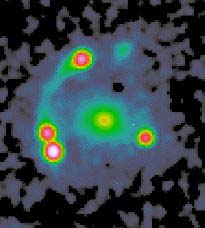This area deals with the fundamental laws and building blocks of nature and how they interact, the properties and the behavior of matter, and research into space and time and their structures.
innovations-report provides in-depth reports and articles on subjects such as astrophysics, laser technologies, nuclear, quantum, particle and solid-state physics, nanotechnologies, planetary research and findings (Mars, Venus) and developments related to the Hubble Telescope.

An international team of scientists from Cambridge, Manchester and Tenerife has released the first results of new high-precision observations of the relic radiation from the Big Bang, often called the cosmic microwave background or CMB.
These observations have been made with a novel radio telescope called the Very Small Array (VSA) situated on Mount Teide in Tenerife. The images show the beginnings of the formation of structure in the early Universe.
From the properties of the image

New evidence suggests that hundreds of unseen dwarf galaxies made of dark matter encircle our Milky Way and other large, visible galaxies. Scientists believe that 80 to 90 percent of the universe must be made of this as-yet-undetected matter to account for the observed structure of the universe. According to Einstein, such large concentrations of matter should warp the surrounding space and bend light in much the same way that glass lenses do. With that in mind, astrophysicists at the University of C

The SUMER instrument on the ESA-NASA SOHO spacecraft has measured amazing wind speeds during its observations of the Sun. It sets a new record in its examination of two loops of gas arching in the solar atmosphere, where NASA`s TRACE satellite spotted bright blobs of gas. Shifts in the wavelength of ultraviolet light from highly ionized neon atoms, seen by SUMER, revealed steady wind speeds of up to 320 000 kilometres per hour. That`s fast enough to cross the Atlantic Ocean in less than a minute.

Over the coming weeks an international team, led by Professor Ulrich Heber of the University of Erlangen-Nuernberg, Germany, will use over fifteen different telescopes around the world to make over one hundred nights of observations of just one star to learn about its internal structure.
The constellation of the “Serpent” contains a variable star, called V338 Ser, which vibrates with several periods of about ten minutes. It is a very old and nearly burnt out star which has lost most of its o

About 30 years ago, astronomers realised that the Sun resonates like a giant musical instrument with well-defined periods (frequencies). It forms a sort of large, spherical organ pipe. The energy that excites these sound waves comes from the turbulent region just below the Sun`s visible surface.
Observations of the solar sound waves (known as “helioseismology”) have resulted in enormous progress in the exploration of the interior of the Sun, otherwise hidden from view. As is the case on Eart

ESO telescopes have detected a strange-looking object. Using the ESO 3.6-m New Technology Telescope and the Very Large Telescope (VLT), a team of astronomers [1] have discovered a dusty and opaque disk surrounding a young solar-type star in the outskirts of a dark cloud in the Milky Way.
It was found by chance during an unrelated research programme and provides a striking portrait of what our Solar System must have looked like when it was in its early infancy. Because of its unusual appeara